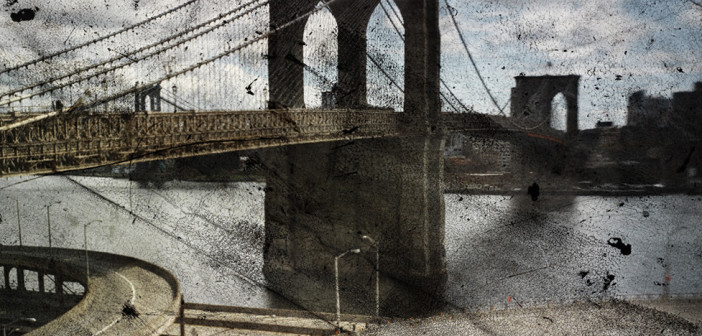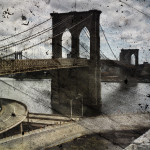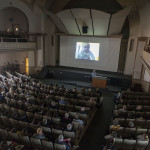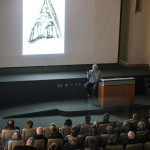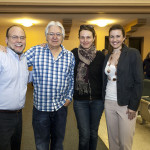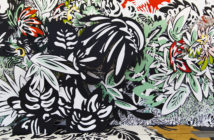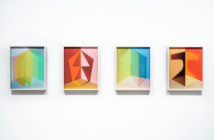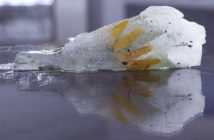 PHSNE President John Dockery, Abe Morell, PRC staff member and former Morell student Julie Kukharenko, and Erin Wederbrook Yuskaitis.
PHSNE President John Dockery, Abe Morell, PRC staff member and former Morell student Julie Kukharenko, and Erin Wederbrook Yuskaitis.Photo by Rene Ricciardi. Courtesy of the Photographic Resource Center
Cuban-born, Boston-based Abelardo Morell has been exploring the very nature of the photographic image for over 30 years as an artist and educator. Best known for turning rooms (and, more recently, a portable domed tent) into camera obscuras and photographing the resulting images of the outdoors projected inside, he's long been fascinated with optics, dimensionality, and perception. At BU's Morse Auditorium on April 21, in a talk presented by the PRC and the Photographic Historical Society of New England, Morell showed slides of his various projects and shared the experiences, inspirations and insights that have shaped his work throughout his career.
After doing mainly street photography through his undergrad (Bowdoin) and grad school (Yale) years and early career, Morell found his vision upended after the birth of his first child. He felt he couldn't make photos in the street anymore, and "sentimental baby pictures" weren't his thing, but he said it "eventually dawned on me to deal with what the present was." He began experimenting with photographing ordinary things at home. "If you can make a paper bag or water look interesting, you can do anything" with photography, he told the audience on Sunday, and it was his early water photos, and seeing water function as a lens, that led him to think about optics and the idea of making the camera itself his subject. "I began making pictures to show the simplicity of photography," he said.
Employing a technique that predates the invention of photography, Morell makes images that are keenly relevant in our digital age. At their most basic, the camera obscura and Tent/Camera images are photos of photos (or of what would be photos if, instead of walls or rooftops, Morell projected the outside view onto film or a photo sensor, as a camera does), making the "original" image a little hard to pin down -- an ephermerality shared by every jpeg in the ether.
And yet Morell's images are lush in their materiality. Much of his work plays with ideas of ground and surface; in his Tent/Camera images, the ground (substrate) for the projected image is literally the ground, outdoors -- dirt, pavement, brick paths, the roofs of buildings. But then the surface of that ground, and the dust, debris, or plant matter on it become textural elements in the photos of the image-projected-on-the-ground, and it becomes less clear whether the physical ground functions as the background of the work, or its surface. This is a question we don't often get to be delighted by when looking at photographs. As an audience member pointed out in the Q&A, many of the works Morell calls 'painterly' aren't merely that -- they're paintings, photographed. Sometimes, as in the camera obscura photos and his projects around books, they're installations or constructions, photographed -- and Morell has taken off on this idea, too, in a project where he went into museums and placed people, sculptures or other objects against paintings, adding his own frames to create new works, photos of things as they aren't-really. "Instead of a Hopper," he quipped of his Nadelman/Hopper mashup, "it's a Hitchcock."
Morell is interested in painting and printmaking, and has physically blurred the lines between photographic and non-photographic processes with Cliché Verre work. The Danforth Museum is showing Continental Drift, Morell's prints of the continents made from hand-drawn negatives, through May 27.
- Abelardo Morell, Tent-Camera Image On Ground: Rooftop View Of The Brooklyn Bridge, Manhattan Side, 2010. Courtesy of the artist and Edwynn Houk Gallery, New York.
- Photo by Rene Ricciardi. Courtesy of the Photographic Resource Center
- Photo by Rene Ricciardi. Courtesy of the Photographic Resource Center
- PHSNE President John Dockery, Abe Morell, PRC staff member and former Morell student Julie Kukharenko, and Erin Wederbrook Yuskaitis. Photo by Rene Ricciardi. Courtesy of the Photographic Resource Center

